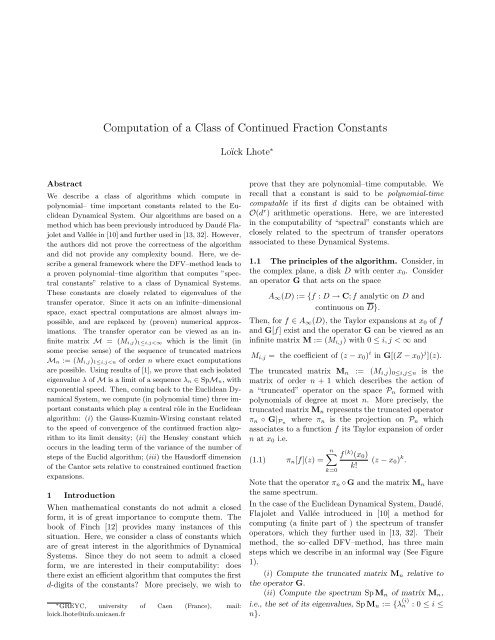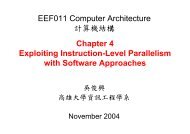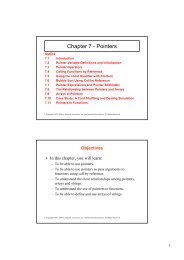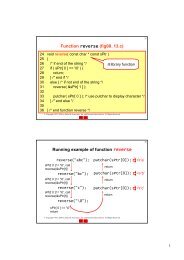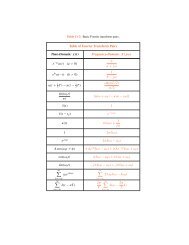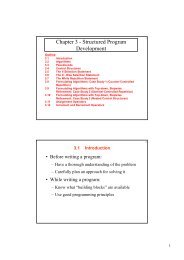Computation of a Class of Continued Fraction Constants
Computation of a Class of Continued Fraction Constants
Computation of a Class of Continued Fraction Constants
Create successful ePaper yourself
Turn your PDF publications into a flip-book with our unique Google optimized e-Paper software.
1.6 Hausdorff dimension and constrained CF –expansions. Consider some integer n and a subset A<strong>of</strong> N n ∗ . Denote by R A the Cantor set <strong>of</strong> reals in I whosecontinued fraction expansion is restricted to A,R A := {x ∈ I ; x = [q 1 , q 2 , . . . , q k , . . .], ∀k ≥ 0,(q kn+1 , q kn+2 , q kn+n ) ∈ A}.As soon as A is different from N n ∗ , the Cantor set R A haszero Lebesgue measure, and the Hausdorff dimensionprovides a precise description <strong>of</strong> it. In particular,the probability that a rational with numerator anddenominator less than N belongs to R A is Θ(N 2sA−2 ),so that the expected time to obtain a rational A–constrained with numerator and denominator less thanN is Θ(N 2−2s A). When A is finite, the reals <strong>of</strong> R Aare interesting since they are all badly approximable byrationals [31].If, furthermore, the set A contains more than oneelement, the Hausdorff dimension <strong>of</strong> R A , denoted bys A , is a real number <strong>of</strong> ]0, 1[, and is proven to be theunique real s ∈]0, 1[ for which the dominant eigenvaluefunction λ A (s) <strong>of</strong> the transfer operator G s,A equals 1.This is why the Hausdorff dimension belongs to the class<strong>of</strong> spectral constants.The Hausdorff dimension <strong>of</strong> the set R A relative toA := {1, 2} has been intensively studied. In 1941,Good [15] showed that 0.5194 ≤ s {1,2} ≤ 0.5433 andin 1982, Bumby [5][6] improved these estimates andobtains s {1,2} = 0.5313 ± 10 −4 . In 1996, Hensley [19]provided a polynomial–time algorithm in the case <strong>of</strong> afinite set A and obtained the following estimations {1,2} ≈ 0.5312805062772051416.Finally, in 1999, Jenkinson and Pollicott [22] designeda powerful algorithm which computes s {1,2} up to 25digits. Note that it is not a polynomial–time algorithm.The DFV–method has been applied (heuristically) tothe case <strong>of</strong> a general set A and seemed to be efficient[32]. We propose a proven polynomial–time algorithmbased on the DFV–heuristics for any subset A 1 × A 2 ×. . . × A n <strong>of</strong> G n . In the particular case when A ⊂ G, itgives rise to proven numerical values <strong>of</strong> s A , and it seemsto run faster than Hensley’s algorithm.2 Polynomial time algorithms for StrictlyContracting Dynamical Systems.As explained in Section 1, we wish to prove the DFV–method. The following definition is natural in thiscontext.Definition 1. [Operator with good truncations.] LetD be a disk <strong>of</strong> center x 0 , and consider an operator Gthat acts on A ∞ (D). Consider the projection π n definedin (1.1) and the truncated operator G n := π n ◦ G.The operator G has good truncations if the followingis true: there is θ < 1 such that, for any simple isolatedeigenvalue λ <strong>of</strong> the operator G, there exist a constantK > 0, an integer n 0 , and a sequence λ n ∈ Sp G n , forwhich, for any n ≥ n 0 , one has:|λ − λ n | ≤ Kθ n .The constant θ is called the truncature ratio.If moreover the triple [θ, K, n 0 ] is computable, then thetruncations are said to be computable.We are interested in constants that arise in spectralobjects relative to complete Dynamical System. Acomplete Dynamical System is a pair (I, T ) formed withan interval I and a map T : I → I which is piecewisesurjective and <strong>of</strong> class C 2 . We denote by G the set <strong>of</strong>the inverse branches <strong>of</strong> T ; then, G k is the set <strong>of</strong> theinverse branches <strong>of</strong> T k . It is known that contractionproperties <strong>of</strong> the inverse branches are essential to obtain“good” properties on the Dynamical System. Usually,what is needed is the existence <strong>of</strong> a disk D which isstrictly mapped inside itself by all the inverse branchesh ∈ G <strong>of</strong> the system [i.e., h(D) ⊂ D]. Here, we have tostrengthen this hypothesis. This motivates the followingdefinition.Definition 2. [Strongly contracting dynamical system.]A complete Dynamical System <strong>of</strong> the intervalI is said to be strongly contracting (SCDS in short)when the set G <strong>of</strong> the inverse branches fulfills the supplementarycondition : For any subset A ⊂ G, there existx 0 ∈ I and two open disks <strong>of</strong> same center x 0 , the largedisk D L , and the small disk D S , with D S D L andI ⊂ D L , such that any h ∈ A is an element <strong>of</strong> A ∞ (D L )which strictly maps D L inside D S [i.e., h(D L ) ⊂ D S ].Remark that (x 0 , R S , R L ) depend on A. The largestpossible ratio R S /R L between the radii R S and R L <strong>of</strong>the two disks is called the A–contraction ratio.A strongly contracting system is said to be extra–contracting (X SCDS in short) if, for any A ⊂ G, thereexist an integer k > 1 and another disk D XL (the extra–large disk) cocentric with D S , with D L ⊂ D XL , suchthat that any h ∈ A k is an element <strong>of</strong> A ∞ (D XL ) whichstrictly maps D XL inside D S [i.e., h(D XL ) ⊂ D S ].We shall prove in the following that many DynamicalSystems relative to Euclidean algorithms belong to theSCDS–setting, and even in the X SCDS–setting.Definition 3. [Transfer operator] Let (I, T ) be<strong>of</strong> SCDS–type. Consider an integer n ≥ 1, a subsetA ⊂ G n , a real σ A ≥ 0, a sequence (α h ) h∈A <strong>of</strong> functions
<strong>of</strong> A ∞ (D L ) positive on D L ∩R, such that, for any s withRs > σ A , the quantityδ(s, A) := ∑ sup |α h (x)| R(s) < ∞.x∈Dh∈A LThen, the relationG s,A [f] = ∑ h∈Aα s h f ◦ h.defines, for Rs > σ A , an operator G s,A : A ∞ (D S ) →A ∞ (D L ) whose norm ‖G s,A ‖ DS ,D Lis at most δ(s, A).Such an operator is called a transfer operator withconstraint A.If moreover the system (I, T ) is <strong>of</strong> X SCDS–type, withan integer k > 1, the operator G k s,A maps A ∞(D S ) intoA ∞ (D XL ).Our first result is as follows:Theorem 1. [A transfer operator has good truncations.]In the SCDS–setting, a transfer operator G s,A :A ∞ (D S ) → A ∞ (D L ) satisfies the following:(ii) It is compact, and its spectrum is formed withisolated eigenvalues <strong>of</strong> finite multiplicity, except perhapsat 0.(ii) for any real s, with s > σ A , the operator G s,A has aunique dominant eigenvalue λ A (s) simple, positive andisolated from the other eigenvalues by a spectral gap.(iii) for any real s, with s > σ A , the operator G s,Ahas good truncations. The truncature ratio θ satisfiesθ ≤ R S /R L where R S and R L are the radii <strong>of</strong> theoptimal pair <strong>of</strong> disks (D S , D L ) relative to A.(iv) In the X SCDS–setting, the truncature ratio satisfiesθ ≤ R S /R XL where R S and R XL are the radii <strong>of</strong>the optimal pair <strong>of</strong> disks (D S , D XL ) relative to A,Now, we prove Theorem 1 and provide explicit constantsfor K, n 0 and θ. The first two assertions are easilyadapted from the works <strong>of</strong> Mayer [30], and we thenfocus on the the pro<strong>of</strong> <strong>of</strong> the third assertion, which ismainly based on two results. We first a well-knownresult <strong>of</strong> functional analysis, which says: “When twooperators are close with respect to the norm, theirspectrums are close too”. The second result showsthat the strongly contraction property entails that thetruncated operators converge in norm to the transferoperator.2.1 Functional analysis. Denote by (B, ‖ ‖) acomplex Banach space and by G an operator which actson B. Denote by Sp G the spectrum <strong>of</strong> G. Considera fixed eigenvalue λ and a circle C = C(λ, r) (withcenter λ and radius r > 0) that isolates λ from theremainder <strong>of</strong> the spectrum. This means that r satisfiesr < d(λ, Sp G\{λ}). The constants α C (G) and β C (G),defined by(2.1) α C (G) := sup ‖ (G − zI) −1 ‖ ,z∈C(2.2){}1β C (G) := max2α C (G) , 1 12rαC 2 (G), 8r 2 αC 3 (G) ,play a central rôle in the paper. They first intervene inthe following result, which is fundamental here.Lemma 1. Let G and ˜G be two operators on theBanach space (B, ‖ ‖). Suppose that λ is a simple andisolated eigenvalue <strong>of</strong> G, with an eigenfunction φ, andconsider an isolating circle C = C(λ, r). Then, if G and˜G satisfy ‖G − ˜G‖ ≤ β C (G), then the operator ˜G hasa unique simple isolated eigenvalue ˜λ in C that satisfies(2.3)|˜λ − λ| ≤ 2r · α C (G) · ‖ ˜G[φ] − G[φ]‖‖φ‖≤2r · α C (G) · ‖ ˜G − G‖.The condition ‖G − ˜G‖ ≤ β C (G) implies, via thedefinition <strong>of</strong> β C (G), three conditions, with a precise goalfor each <strong>of</strong> them. The first condition ensures that thecircle C is also included in the resolvant set <strong>of</strong> ˜G. Thesecond condition implies that ˜λ is the unique eigenvalue<strong>of</strong> ˜G in C. Finally, with the last condition, it is possibleto relate the two spectral spaces related to λ and ˜λ.This proposition will be also useful for computing theHensley constant (in Section 4.2).2.2 Convergence <strong>of</strong> truncated operators in theSCDS–setting. Consider any operator G : A ∞ (D S ) →A ∞ (D L ). We recall that the non-zero eigenvalues <strong>of</strong>the operator π n ◦ G and the matrix M n are the same.Then, according to the previous Lemma, it is sufficientto obtain the convergence <strong>of</strong> π n ◦ G to G (in norm).This is the aim <strong>of</strong> the following lemma, which requiresthe strong contracting property. A pro<strong>of</strong> restricted tothe framework <strong>of</strong> <strong>Continued</strong> <strong>Fraction</strong>s can also be foundin [20] with slightly different functional spaces.Lemma 2. Consider an operator G : A ∞ (D S ) →A ∞ (D L ) with norm ‖G‖ DS ,D L. Then, one has:‖π n ◦ G − G‖ DS ≤ ‖G‖ DS ,D LR LR L − R S(RSR L) n+1.Suppose furthermore that there exists some disk D XL ,with D L ⊂ D XL , and some k–th iterate <strong>of</strong> G whichmaps A ∞ (D S ) into A ∞ (D XL ). Then, for any eigenfunctionφ <strong>of</strong> G,‖π n [φ] − [φ]‖ DS‖φ‖ DS≤ ‖φ‖ ( ) n+1D XLR XL RS·.‖φ‖ DS R XL − R S R XL
More precisely, (see [3]), if the cost c is <strong>of</strong> “moderategrowth”, the variance <strong>of</strong> the total cost <strong>of</strong> an executioncan be expressed with the derivatives (<strong>of</strong> order 1 or 2) <strong>of</strong>the dominant eigenvalue λ s,w <strong>of</strong> G s,w . If the cost is <strong>of</strong>“large growth”, then the Hausdorff dimension relativeto this cost also involves the dominant eigenvalue λ s,w([7]). And the DFV–method can be proven to apply,with exponential rate <strong>of</strong> convergence.The list <strong>of</strong> these possible applications <strong>of</strong> Theorem 1is not exhaustive. We now focus on the standardEuclidean dynamical system, where it is possible toprovide estimates for the pair [K, n 0 ].3 Proven <strong>Computation</strong> <strong>of</strong> the constants in theEuclidean caseWe come back now to the Euclidean Dynamical Systemand its (usual) transfer operators G s,A relative to α h =|h ′ |. The formulae (2.5) (2.6) which define θ, n 0 and Kinvolve two kinds <strong>of</strong> constants. The constants R S , R L(and R XL ), are closely related to the definition <strong>of</strong> theoperators and are <strong>of</strong>ten easy to compute. This entailsthat the rate θ is in general easy to compute.Then, we have to find an isolating circle C(λ, r), whichneeds an estimate <strong>of</strong> λ and a lower bound for thespectral gap around λ. We prove in Lemmas 3 and4 that it is possible, at least when λ = λ A (s) is thedominant eigenvalue,If we use the X SCDS–setting, we wish to obtain anestimate <strong>of</strong> the eigenfunction φ relative to λ.On the other hand, even when C = C(λ, r) is welldefined,a lower bound for the constant β C (G), givenin (2.2) is not easy to compute. It involves, via thedefinition <strong>of</strong> α C (G) in (2.1) an upper bound for thenorm <strong>of</strong> an inverse operator. Such an upper bound is ingeneral hard to compute. However, when G is normal,an explicit an expression for α C (G) are known,(3.1) α C (G) =1d(C, Sp G)(we recall that G is normal when it commutes withits dual G ⋆ ) But the normality is a rare phenomenon,which is difficult to prove. Here, it is not true thatthe transfer operator G s,A is normal on spaces A ∞ (D);however, there exists another functional space (a Hardyspace, denoted by H s,A , which depends on (s, A) whereG s,A is normal (note that this normality phenomenondoes not seem to hold for the two other DynamicalSystems C, O). Even if the two spaces, the Hardy spaceand the space A ∞ (D) are different, the associated normscan be compared, and this provides an upper bound forα C (G s,A ), and a lower bound for β C (G). Finally, theresults <strong>of</strong> this Section lead to the second main result <strong>of</strong>the paper.Theorem 2. The (standard) Euclidean DynamicalSystem is a system <strong>of</strong> X SCDS–type. For any A ⊂ G, thetriple [K, n 0 , θ] used for approximating the dominanteigenvalue λ A (s) can be estimated, and there exists aneffective algorithm that computes λ A (s) in polynomial–time.The remainder <strong>of</strong> the Section is devoted to provingTheorem 2.3.1 Disks D S , D L , D XL and truncature ratio.We recall that we deal with the Euclidean system, wherethe set <strong>of</strong> inverse branches G is defined in (1.3). Here,we consider a subset A <strong>of</strong> G and A denotes the set <strong>of</strong>indices <strong>of</strong> A. We denote by m A the minimum <strong>of</strong> A.Then the disks D S , D L can be chosen asx 0 := 1m A, R S = 1m A, R L = 1m A+ m A2 ,R SR L=22 + m 2 .AFurthermore, the operator G 2 s,A maps A ∞(D S ) into theset <strong>of</strong> functions which are analytic in the half plane{R(z) > −m A }. We then can choose for the disk D XLany disk <strong>of</strong> center x 0 and radiusR XL = 1m A+ m A − ɛ,R SR XL=(with ɛ > 0), so that11 + m 2 A − ɛm .A3.2 Estimate for the dominant eigenvalue λ A (s)<strong>of</strong> G s,A . We use the following classical result previouslyused in [10]:Let G be an operator which acts on the space <strong>of</strong>analytic functions on an interval [a, b]. Furthermore,the operator G is positive (i.e., G[f] > 0 if f > 0) andhas a unique dominant eigenvalue λ isolated from theremainder <strong>of</strong> the spectrum by a spectral gap. Supposethat there exist two strictly positive constants c 1 and c 2and a function f which is strictly positive and analyticon [a, b] and satisfies c 1 f(x) ≤ G s,A [f](x) ≤ c 2 f(x), forany x ∈ [a, b]. Then, the dominant eigenvalue λ satisfiesc 1 ≤ λ ≤ c 2 .Denote by m A the minimum <strong>of</strong> A and by M A its supremum(possibly infinite if A is infinite). By convention,if M A = ∞, we put h MA = 0. Each LFT h MA ◦ h mA orh mA ◦ h MA is called an extremal LFT; it has a uniquepositive fixed point, denoted by a A or b A . Then thedisk D A with diameter [a A , b A ] is the smallest diskwhich is mapped into itself by all the elements <strong>of</strong> A.The application <strong>of</strong> the previous result with the operatorG s,A and the functions f = 1 for the upper bound
Lemma 5. For any complex s with R(s) >max(σ A , 0),(i) the transfer operator G s,A : H s,A → H s,A isisomorphic to an integral operator; it is normal and selfadjointfor real values <strong>of</strong> s. Thus, for real values <strong>of</strong> s,the spectrum <strong>of</strong> G s,A is real.(ii) the spectrum <strong>of</strong> G s,A on H s,A and the spectrum <strong>of</strong>G s,A on A ∞ (D S ) are the same.(iii) Let D be an intermediary disk <strong>of</strong> center x 0 andradius R with R S < R < R L and f a function <strong>of</strong>A ∞ (D). For any subset A <strong>of</strong> G, the function G s,A [f]belongs to H s,A .(iv) Define, for any R (with R S < R < R L ), threeconstants κ 1 , κ 2 , κ 3 (which depend on x 0 , s, A, R),(3.6)κ 1 = ζ A (2s, x 0 − R), κ 2 = Γ(2s) · ζ A (2s, 2(x 0 − R)),(3.7)κ 3 = ∑ j≥0( ) ( j RSRj!Γ(2s + j)with γ j = e x0/(j+1) .Then, the following is true:(3.8)(3.9)) 1/2(γ j R S ) 2sγj 2s − 1 + ζ A(2s, 0)Γ(2s) 2‖G s,A [f]‖ D ≤ κ 1 · ‖f‖ DS for f ∈ A ∞ (D)‖f‖ D ≤ κ 2 · ‖f‖ for f ∈ H s,A ,(3.10) ‖G s,A [f]‖ ≤ κ 3 · ‖f‖ Dfor f ∈ A ∞ (D).Before proving Lemma 5, we explain how it provides anestimate for α C (G s,A ). Consider the isolating circle C<strong>of</strong> center λ A (s) and radius r A (s) described in Lemma4,and consider a point z ∈ C. The two inclusionsG s,A [A ∞ (D S )] ⊂ A ∞ (D) andG s,A [A ∞ (D)] ⊂ H s,A ,together with the relationz(G s,A − zI) −1 = (G s,A − zI) −1 G s,A − Ientail the following(3.11)|z| ‖(G s,A − zI) −1 ‖ DS ≤ κ 1 · ‖(G s,A − zI) −1 ‖ D + 1,(3.12)|z| ‖(G s,A −zI) −1 ‖ D ≤ κ 2·κ 3·‖(G s,A −zI) −1 ‖ +1.Now, G s,A is normal on H s,A , so that‖(G s,A − zI) −1 ‖ =1d(z, Sp G s,A ). Finally, with the formulae (3.11) and (3.12), theinequality‖(G s,A − zI) −1 ‖ ∞,DS ≤ 1 ( )κ1 · κ 2 · κ 3|z| 2 + 1 + 1r A |z| ,holds. Now, the estimate <strong>of</strong> λ A (s) (given in Lemma 3)yields that any z ∈ C satisfies|z| ≥ ζ A (2s, b) − r A (s) > 0and an upper bound <strong>of</strong> α C (G s,A ) follows. Finally, weobtain:Lemma 6. Denote by r A (s) the lower bound <strong>of</strong> Lemma4. For any intermediary radius R, with R S < R < R Land s > max(0, σ A ), there exist constants κ i defined inLemma 5 (which depend on x 0 , R, s, A), for which(3.13)α C (G s,A ) ≤ κ 1 · κ 2 · κ 3 + r A (s)[1 − r A (s) + ζ A (2s, b A )]r A (s)[ζ A (2s, b A ) − r A (s)] 2 ,Pro<strong>of</strong> <strong>of</strong> Lemma 5. For (i) and (ii), we refer tothe work <strong>of</strong> Jenkinson, Gonzalez and Urbański [21],and we mainly deal with (iii) and (iv). The strongcontraction condition implies the inequality (3.8). Theinequality (3.9) is a direct application <strong>of</strong> the Cauchy-Schwartz inequality with the identityΓ(s)ζ A (s, z) =∫ ∞0t s−1 e −zt dν A (t).The pro<strong>of</strong> <strong>of</strong> inequality (3.10) is more involved and weonly explain here its main steps. First Hensley [20] hasshown that, for all j ≥ 0, the function G s,A [(X − x 0 ) j ]is an element <strong>of</strong> H s,A whose integral representationis closely related to generalised Laguerre polynomialsL (2s−1)j . The Laguerre polynomials (L (p)j ) form anorthogonal basis for the weight t p e −t on ]0, ∞[ and theyverify the formulaL (p) Γ(p + 1 + j)j (x) =j!∑( ) jj(−1) k kk=0The function G s,A [(X − x 0 ) j ] then satisfy∫ ∞0G s,A [(X − x 0 ) j ](z) =[t s−1/2 e −tz (−x0 ) j j!Γ(2s + j) ts−1/2 L 2s−1jWe deduce that the norm is given by‖G s,A [(X − x 0 ) j ]‖ 2 =[ (−x0 ) j ] 2 ∫j! ∞Γ(2s + j) 0x kΓ(p + 1 + k) .( tx 0)]dν A (t)t 2s−1 L 2s−1j (t)dν A (x 0 t).
But the Laguerre polynomials are positive and decreasingon [0, 2s/(j + 1)]. Using these properties with somerelations <strong>of</strong> orthogonality and splitting the integrand∫ ∞into ∫ 2s/(j+1)+ ∫ ∞, we prove the inequality0 0 2s/(j+1)∀j ≥ 1, ‖G s,A [(X − x 0 ) j ]‖ ≤ K jK j+1K j→ R S .withNow, the i–th coefficient c i <strong>of</strong> the Taylor expansion <strong>of</strong>f ∈ A ∞ (D) at x 0 satisfies R j |c j | ≤ ‖f‖ D and finally‖G s,A [f]‖ ≤ κ 3 · ‖f‖ D with κ 3 = ∑ j≥0K jR jNote that the previous series converges exponentiallyfast.Finally, the constants K and n 0 defined in (2.5) and(2.6)involve the isolating circle C whose center λ A (s) andradius r A (s) together with α C (G s,A ). Since all thesequantities are computable, this proves Theorem 2.4 Application <strong>of</strong> the DFV-Mehtod to threeconstantsThis section applies the previous results and provides(in polynomial–time, via the DFV-Method) proven numericalvalues for three continued fraction constants:the Gauss-Kuz’min-Wirsing constant, the Hensley constantand the Hausdorff dimension <strong>of</strong> the Cantor setsR A with A ⊂ G.In the second step <strong>of</strong> the DFV–method, we deal withcomputations on the matrix M s,A,n . First, we have tobuild the matrix; second we have to find the roots <strong>of</strong>det(M s,A,n − zI n ). Then we conclude:For any subset A ⊂ G, building matrix M s,A,n needsO(n 3 ) multiplications and additions on reals and 2n + 1computations <strong>of</strong> ζ A (s) functions; Computing Sp M s,A,nneeds at most O(n 4 ) arithmetical operations (with abad method).In this section, we shall prove the last result <strong>of</strong> thepaper:Theorem 3. For the three following constants –the Gauss-Kuz’min-Wirsing constants, the Henley constants,the Hausdorff dimension relative to constraintsA ⊂ G– it is possible to provide d proven digits inpolynomial–time in d.4.1 Algorithm for the Gauss-Kuz’min-Wirsingconstant. The Gauss-Kuz’min-Wirsing constant γ G isthe unique subdominant eigenvalue <strong>of</strong> G 1 . It is real.It is possible to estimate a circle C that isolates γ Gtogether with the associated constant α C (G 1 ). Thus,the DFV-method provides proven numerical values forγ G . Only one computation <strong>of</strong> matrix is needed, and thecomplexity <strong>of</strong> γ G is <strong>of</strong> order four. Numerical results aresummarized up in Figure 4.1.4.2 Algorithm for the Hensley constant.The Hensley constant (see 1.8) involves the first twoderivatives <strong>of</strong> λ(s) at s = 1. Since the first derivativeλ ′ (1) has a closed form λ ′ (1) = −π 2 /(6 log 2), it remainsto compute the second derivative λ ′′ (1). Consider aninterval I h <strong>of</strong> the form I h := [1 − h, 1 + h] and supposethat an estimate ˜λ <strong>of</strong> λ satisfiesmax(|λ(1 + h) − ˜λ(1 + h)|, |λ(1 − h) − ˜λ(1)− h)|≤ h2 ɛ3 .Then Taylor’s formulae entail the estimate(1) − ˜λ(1 − h) + ˜λ(1∣+ h) − 2 ∣∣∣∣∣ λ′′ h 2≤ 2ɛ3 + h224 sup |λ (4) |I hIt then suffices to know an upper bound for the fourthderivative λ (4) on the interval I h . The applications → G s is analytic and the derivative G ′ s satisfies‖G ′ s‖ DS ≤ 8 for s ≥ 0.9. Then, ‖G s −G 1 ‖ DS ≤ 8|s−1|.We apply Lemma 3: the circle C <strong>of</strong> center 1 and radiusr 1 := (1−γ G )/2 is an isolating circle for λ = 1. Then, ifs satisfies |s − 1| < r 2 with r 2 = β C (G)/8, the operatorG s admits a unique simple isolated eigenvalue λ(s) inC which satisfies |λ(s)−1| ≤ r with r := 16 r 1 r 2 α C (G)as soon as |s − 1| ≤ r 2 . Since the application s → G sis analytic, the function s → λ(s) is analytic too. TheCauchy formula, applied in the disk <strong>of</strong> center 1 andradius r 1 yields the upper boundsup[1−h,1+h]|λ (4) 1 + r| ≤ 4!(r 1 − h) 4 .Then, γ H is computable as soon as the two estimatesfor λ(1 + h) and λ(1 − h) are known (asymptotically towithin twice the required precision). This thus needstwo computations <strong>of</strong> the step 2 <strong>of</strong> the DFV–method.Tabular 4.2 summarizes some numerical results.4.3 Algorithm for the Hausdorff dimension.The algorithm uses a classical dichotomy principle andcomputes a sequence <strong>of</strong> intervals <strong>of</strong> length 2 −k whichcontain the Hausdorff dimension s A . Consider theinterval [u k−1 , v k−1 ] obtained after (k − 1) steps (it is<strong>of</strong> length 2 −(k−1) and contains s A . Denote by w k the
digits time proven value10 11s -0.303663002820 1m46 -0.3036630028987326585930 9m54 -0.30366300289873265859744812190140 34m710 -0.303663002898732658597448121901556233110850 1h41 -0.30366300289873265859744812190155623311087735225365Figure 2: Gauss-Kuz’min-Wirsing constantdigits time proven value5 2m30s 0.5160610 7m30s 0.516062408915 41mn 0.51606240889999120 2h33mn 0.51606240889999180681Figure 3: Hensley constantmiddle point <strong>of</strong> the interval [u k−1 , v k−1 ] and computean estimate ˜λ <strong>of</strong> λ A (w k ) within 2 −(k+1) . Now, thereare three possible cases:(i) If ˜λ − 1 − 2 −(k+1) ≥ 0 then s A ≥ w k and[u k , v k ] := [w k , v k−1 ].(ii) If ˜λ − 1 + 2 −(k+1) ≤ 0 then s A ≤ w k and[u k , v k ] := [u k−1 , w k ](iii) Else, [u k , v k ] := [w k − 2 −(k+1) , w k + 2 −(k+1) ]This algorithm is just a classical binary splitting. Thepro<strong>of</strong> that s A belongs to [u k , v k ] is based on the strictdecrease <strong>of</strong> λ together with the inequality |λ A (s) −λ A (s + h)| ≥ h. There are at most O(d) iterations, each<strong>of</strong> them <strong>of</strong> cubic complexity (in d). Thus, the complexity<strong>of</strong> the algorithm is asymptotically O(d 5 ). Numericalresults are given in Figure 4.3 for the Cantor set R {1,2} .5 ConclusionWe proved here that the DFV-method gives rise to analgorithm that computes any isolated simple eigenvalue<strong>of</strong> a transfer operator, in polynomial–time, providedthat two conditions are fulfilled: (i) the operator hasgood truncations and (ii) the matrices M n are easy tocompute.However, if we are interested in actual proven numericalvalues, we need evaluating the parameters that intervenein the design <strong>of</strong> the algorithm. These parametersare in general difficult to compute, but we solve thisdifficulty for the transfer operators relative to the StandardEuclidean Algorithm.The DFV-method can also be used to compute theHausdorff dimension <strong>of</strong> the Cantor sets R A with A <strong>of</strong>the form A = A 1 × A 2 × . . . × A n , A i ∈ H. However,the computation <strong>of</strong> the matrix is more involved since itscoefficients deal with more complicated zeta–functions.Finally, the authors <strong>of</strong> [10] and Sebah used the DFVmethodwith x 0 = 1/2. This particular choice donot enter our framework since no disk <strong>of</strong> center 1/2is strictly mapped into itself. We can use any diskD L <strong>of</strong> center 1/2 + δ with radius 1/2 + 2δ diameter[−δ, 1 + 3δ] with δ > 0. This leads to truncature ratioR S /R XL which tends to 1/3 − ɛ as δ tends to zero,which is the convergence rate actually observed by theauthors. However, our method <strong>of</strong> Section 3.4 does notseem to apply there, and we do not know how to obtainan estimate for the pair [K, n 0 ] in this setting.References[1] M. Ahues, A. Largillier, V. Limaye. Spectralcomputations for bounded operators, Chapman &Hall/CRC (2001).[2] K. I. Babenko. On a problem <strong>of</strong> Gauss, Soviet Math.Dokl. 19 (1978), 136-140.[3] V. Baladi and B. Vallée. Euclidean algorithms areGaussian, Les Cahiers Du GREYC, Université deCaen (2003)[4] K. Briggs. A Precise <strong>Computation</strong> <strong>of</strong> the Gauss-Kuzmin-Wirsing Constant. Preliminary report. 2003July 8.http://research.btexact.com/teralab/documents/wirsing.pdf.[5] R. T. Bumby. Hausdorff dimension <strong>of</strong> Cantor sets, J.Reine Angew. Math. 331 (1982), 192-206[6] R. T. Bumby. Hausdorff dimension <strong>of</strong> sets arisingin number theory, Number Theory (New-York, 1983-1984), Lecture Notes in Math., 1135, Springer, 1985,pp. 1-8[7] E. Cesaratto. Thesis, University <strong>of</strong> Buenos Aires,2003[8] T. Cusik. Continuants with bounded digits, Matematika24 (1977), 166-172[9] T. Cusik. Continuants with bounded digits II, Matematika25 (1978), 107-109[10] H. Daudé, P. Flajolet, B. Vallée. An Average-Case Analysis <strong>of</strong> the Gaussian Algorithm for LatticeReduction, Combinatorics, Probability and Computing(1997) 6, pp 1-34[11] J. G. Dixon. The number <strong>of</strong> steps in the Euclideanalgorithm, J. Number Theory, 2 (1970), 414-422
digits time proven value <strong>of</strong> s {1,2}5 2m 0.5312810 8m 0.531280506215 25m 0.53128050627720520 1h 0.5312805062772051416230 4h26 0.53128050627720514162446864736840 14h11 0.531280506277205141624468647368471785493045 23h10 0.531280506277205141624468647368471785493059109Figure 4: Hausdorff dimension <strong>of</strong> R {1,2}[12] S. Finch. Mathematical <strong>Constants</strong>. Cambridge UniversityPress (2003)[13] Ph. Flajolet and B. Vallée. <strong>Continued</strong> <strong>Fraction</strong>s,Comparison Algorithms, and Fine Structure <strong>Constants</strong>,in Constructive, Experimental et Non-LinearAnalysis, Michel Thera, Editor, Proceedings <strong>of</strong> CanadianMathematical Society, Vol 27 (2000), pages 53-82[14] C. F. Gauss. Recherches Arithmétiques, 1807, printedby Blanchard, Paris, 1953[15] I. J. Good. The fractional dimension <strong>of</strong> continuedfractions, Proc. Camb. Phil. Soc. 37 (1941), 199-228.[16] A. Grothendieck. Produits tensoriels topologiques etespaces nuclaires, Mem. Am. Math. Soc. 16 (1955)[17] H. Heilbronn. On the average length <strong>of</strong> a class <strong>of</strong>continued fractions, Number Theory and Analysis,P. Turan, ed., Plenum, New York, 1969, pp. 87-96[18] D. Hensley. The number <strong>of</strong> steps in the Euclideanalgorithm, J. Number Theory, 49(2) 142-182[19] D. Hensley. A polynomial time algorithm for theHausdorff dimension <strong>of</strong> a continued fraction Cantor set,J. Number Theory, 58(1)(1996), 9-45[20] D. Hensley. <strong>Continued</strong> <strong>Fraction</strong>s, World Scientific,book to appear[21] O. Jenkinson, L.F. Gonzalez, M. Urbański. Ontransfer operators for continued fractions with restricteddigits Proc. London Math. Soc., to appear.[22] O. Jenkinson and M. Pollicott. Computing thedimension <strong>of</strong> dynamically defined sets I: E 2 andbounded continued fractions, preprint, Institut deMathématiques de Luminy, 1999.[23] M. Krasnoselskii. Positive solutions <strong>of</strong> operatorequations, P. Noordh<strong>of</strong>f, Groningen, 1964.[24] R.O. Kuz’min. On a problem <strong>of</strong> Gauss, Atti del Congressointernazionale dei matematici, Bologna, 1928,Vol. 6, 83-89[25] D. Lamé. Note sur la limite du nombre de divisionsdans la recherche du plus grand commun diviseur entredeux nombres entiers, C. R. Acad. Sc. 19 (1845) 867-870[26] P. Levy. Sur la loi de probabilité dont dépendentles quotients complets et incomplets d’une fractioncontinue, Bull. Soc. Math. France 57 (1929) 178-194[27] D. H. Mayer. On composition operators on Banachspaces <strong>of</strong> holomorphic functions, J. Funct. Anal. 35(1980), 191-206[28] D. H. Mayer. <strong>Continued</strong> fractions and related transformations,Ergodic Theory, Symbolic Dynamics andHyperbolic Spaces, T. Bedford, M. Keane and C. Series(eds), Oxford University Press, 1991, 175-222.[29] D. H. Mayer. On the thermodynamic formalism forthe Gauss map, ibid. 130 (1990), 311-333.[30] D. H. Mayer. Spectral properties <strong>of</strong> certain transfercomposition operators arising in statistical mechanics,Communications in Mathematical Physics, 68(1979),1-8[31] J. Shallit. Real Numbers with Bounded Partial Quotient:A Survey in G?, (M. Rassias Ed.), The MathematicalHeritage <strong>of</strong> Carl Friedrich Gauss, World Scientific,Singapore, 1991.[32] B. Vallée. Dynamique des fractions continues contraintespriodiques, Journal <strong>of</strong> Number Theory72(1998), no. 2, 183–235.[33] B. Vallée. Opérateurs de Ruelle-Mayer généralisés etanalyse en moyenne des algorithmes d’Euclide et deGauss, Acta Arithmetica, 141.2 (1997).[34] B. Vallée. Dynamical Analysis <strong>of</strong> a class <strong>of</strong> EuclideanAlgorithms, Theoretical Computer Science, vol 297/1-3 (2003) pp 447–486[35] B. Vallée. Algorithms for computing signs <strong>of</strong> 2 × 2determinants: dynamics and average–case analysis,Proceedings <strong>of</strong> ESA’97, LNCS 1284, pp 486–499.[36] E. Wirsing. On the theorem <strong>of</strong> Gauss-Kusmin-Lévyand a Frobenius-type theorem for function spaces, ActaArith. 24 (1974), 507-528


